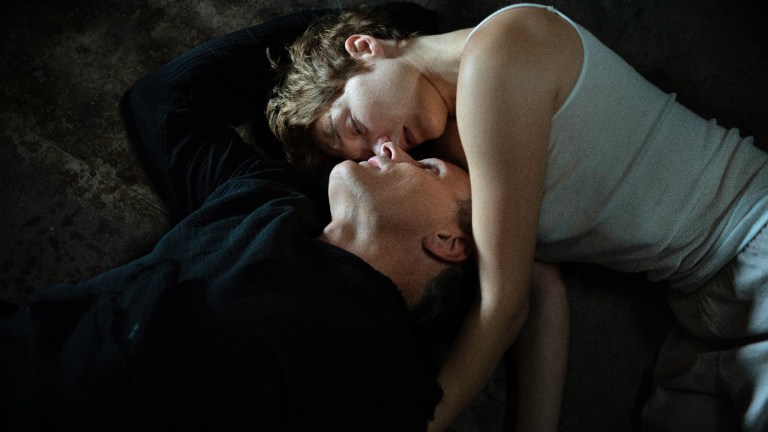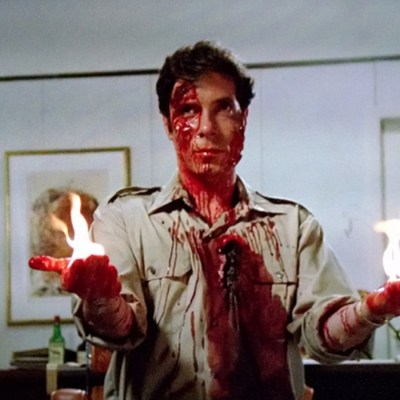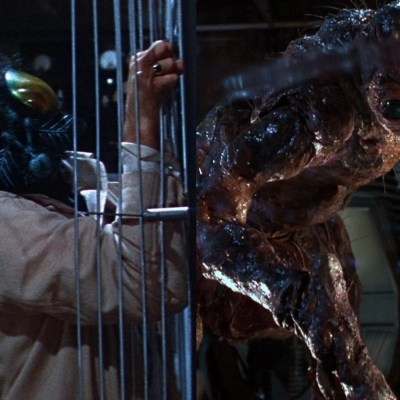David Cronenberg: What If Body Horror and Transformation is ‘a Good Thing?’
Exclusive: David Cronenberg, Viggo Mortensen, and Léa Seydoux take us inside Crimes of the Future, and if the physical transformation of the human species is "a good thing?"

Fans of intelligent, thought-provoking, and visionary films that just happen to have strange new appendages growing out of the human body were thrilled when it was revealed David Cronenberg was returning to body horror with Crimes of the Future. Further, the new thriller marks the end of the Canadian director’s eight-year hiatus from filmmaking as well.
They had reason to cheer loud, as the movie really does feature bizarre, unidentifiable organs being removed from the body of pain-wracked performance artist Saul Tenser (Viggo Mortensen) in front of live audience—a clear nod to early films like The Brood, Videodrome, and The Fly that put Cronenberg on the map as a master of the body horror subgenre.
Cronenberg’s career has taken him down a number of other avenues artistically, with many of his films evolving away from the visceral gut-punch of his early work, but he’s never fully left genre material behind. In fact, the script for Crimes of the Future was actually written more than 20 years ago, and Cronenberg tells Den of Geek now that he didn’t change a thing when he took it out again.
“It didn’t change at all,” the director says. “I did one draft in, like, 1998, and that’s the script that we went into production with. So in terms of script, not one word was changed. But of course, things have changed in terms of producing it—we ended up shooting in Athens instead of Toronto, and so on. So things change in the course of production, but that’s normal.”
Viggo Mortensen, for whom Crimes of the Future is his fourth collaboration with Cronenberg, says he and the director discussed various projects over the years while Cronenberg was away from filmmaking, with Cronenberg even showing Mortensen galleys of Consumed, the novel he published in 2015. Mortensen thought for sure that his friend and director might stick with that medium.
“It seemed like he was saying he was done, he might write screenplays for others to direct, but the whole process of trying to get a movie going and shooting was too difficult or too time consuming,” Mortensen explains. “So I was really glad when he said, ‘I’m going to do this’—he had a couple of different scripts, and this is the one he ended up deciding to do. I was very happy that the world was going to get to see a new David Cronenberg movie, whether I was part of it or not.”
Cronenberg himself is candid about why this was the right time for him to make a new movie.
“Really, the only reason the time was right now was that I had a very aggressive, supportive producer who was willing to suffer to finance the movie,” Cronenberg says. “That’s really it. I mean, there’s no thematic or political or religious, or mystical reason for a movie to exist at all, frankly. So it comes down to very pragmatic indie filmmaking.”
Longtime Cronenberg devotees familiar with the beginnings of his career know that Crimes of the Future was also the name of one of two early features he self-produced, wrote, and directed while still a student at the University of Toronto (the other film was called Stereo). But the two movies are very different in terms of their plot, characters, and filmmaking expertise, although the intensely cerebral aesthetic and fascination with changes in human physiology are still present in both.
“Originally, the script [for the new film] was called Painkillers,” says Cronenberg. “And there were in the time between then and now five novels called Painkillers and three streaming series, and a couple of movies, so we just thought that it was no longer viable as a title, even though it was appropriate. And my producer said, ‘Why don’t we just steal the title from your old movie Crimes of the Future? Because that would really fit.’ And I said, ‘Oh, yeah, great. Let’s do that.’ That’s pretty much it.”
Cronenberg insists that there was “not a lot of thought” about the resonance of using one of his oldest titles for not just a new film but one that returns in many ways to the themes and imagery that established him as one of horror’s most potent and challenging filmmakers in the 1970s and ‘80s.
“I have to assume that most people who see this movie will not know about that movie,” he says. “But even if they do, they’ll see there are connections, because that movie was also legitimately called Crimes of the Future, but it was an extremely low-budget, underground film that I shot myself, edited myself, with non-professional actors and so on. So it’s a very different thing. And yet connected, no doubt.”
For Mortensen, starring in Crimes of the Future as Saul, whose own body seems to continually betray him, leaving the artist in a perpetual state of physical discomfort, also gave him the chance to work on a “classic” Cronenberg exercise after doing three films into more psychological drama territory: A History of Violence, Eastern Promises, and A Dangerous Method.
“It’s true, he’s sort of gone back to what he was doing before I met him 25, 30 years ago, but with new technology, and also with new, well-earned confidence as an artist,” says Mortensen. “He knows exactly what he wants. He’s editing as he’s making the movie, really. He’s very self-assured. Even when I read the script, it was like, ‘Okay, these are going to be some intense images.’ But that wasn’t the main thing that drew me to it. I liked the love story that’s at the heart of it, that there’s a surprising kind of tenderness, and something sweet and even funny at times about the story, in a strange way.”
For Léa Seydoux, who plays Saul’s partner Caprice, working with both Cronenberg and Mortensen for the first time was the kind of acting adventure that she had craved for a long time. “I really wanted to work with David but also with Viggo,” the No Time to Die star says. “I didn’t exactly know what it was going to be like, because David has such a specific way of telling stories, but I was drawn to the fact that I didn’t know what to expect. This is also the reason why I love doing this—to have new experiences and new emotions.”
Scott Speedman (Animal Kingdom) plays Lang Dotrice, a grieving father and underground activist leader who sees Saul’s mutations as the bleeding edge of a radical new turning point in human evolution.
“It was a great experience for me,” Speedman says. “Having done this for almost 30 years now, you just want more than ever to work with filmmakers who don’t have much of an agenda other than to simply make what they’re trying to make—just shooting the movie that David intended to shoot and have it actually appear onscreen in some form of what we intended, that’s the greatest gift to me.”
In this day and age, when the movie business itself is mutating on a seemingly ongoing basis, it’s something of a miracle that a filmmaker with a sustained, coherent vision can still manage to make films that are instantly recognizable as theirs, even as the filmmaker and the themes that he, she, or they are interested in continue to evolve as well.
Cronenberg has been intrigued over the course of his entire career with the evolution of the human body and mind, and how they intersect and co-exist with the progression of technology, but unlike some of his earlier films, Crimes of the Future suggests that this is a change we might want to embrace instead of reject outright.
“It’s sort of saying, okay, let’s say that this transformation of the human body that I believe, in fact, is happening because of technology, because of the internet, because of digital media and all of that—I think our nervous systems are adapting to that and are actually changing,” he explains. “Therefore we are literally physically quite different from human beings 100 years ago, not to mention 2,000 years ago.”
He continues, “It’s like a diamond that has many facets. You’re looking into the same interior, but from different facets of the diamond, and you’re saying, what if we stopped fighting this? What if in fact, what’s happening is a good thing? It’s easy to see that it could be bad, but what if it’s actually good? Let’s just imagine that and spin a narrative where that’s actually the case. Let’s see where that leads us.”
Crimes of the Future is in theaters now.


